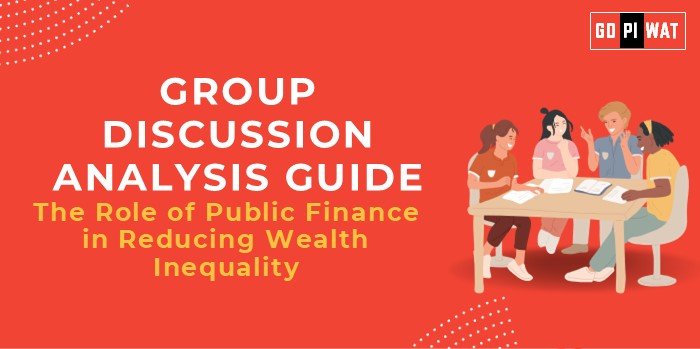📋 Group Discussion Analysis Guide: The Role of Public Finance in Reducing Wealth Inequality
🌐 Introduction
Context: Globally, wealth inequality has been a persistent challenge, with the richest 1% holding over 40% of total wealth. Public finance plays a pivotal role in narrowing these disparities by redistributing wealth through taxation, subsidies, and welfare programs.
Background: The concept of public finance centers on government revenues and expenditures aimed at achieving socio-economic objectives. Historical models, such as the Nordic welfare states, demonstrate how well-structured public finance systems can foster equitable growth. Recent OECD studies highlight an increasing reliance on progressive taxation and social safety nets to mitigate inequality.
📊 Quick Facts and Key Statistics
- 🌍 Top 1% Wealth Share: 43% globally (2023) – Reflects stark wealth concentration.
- 📉 Tax Revenue as % of GDP (India): ~11.7% (2022) – Indicates limited fiscal space for redistribution.
- 💰 Public Welfare Spending: Nordic countries invest 25%+ of GDP compared to India’s ~6%.
- 📈 Global Gini Coefficient Trend: Increased from 0.35 in 2000 to 0.39 in 2022 – Highlights growing disparities.
🧑🤝🧑 Stakeholders and Their Roles
- 🏛️ Government Bodies: Implement taxation, welfare programs, and regulatory measures.
- 🌐 International Organizations (e.g., IMF, World Bank): Provide financial aid and policy frameworks.
- 🏢 Private Sector: Contribute via corporate taxes and CSR initiatives.
- 👥 Civil Society: Advocate for equitable policies and monitor wealth distribution.
🏆 Achievements and Challenges
🎯 Achievements:
- Progressive Taxation Models: Countries like Denmark achieve low Gini coefficients (0.28) through high marginal tax rates.
- Public Health and Education Investments: Brazil’s Bolsa Família lifted 13 million people out of poverty.
- Infrastructural Development: India’s MGNREGA created 2.6 billion workdays in 2023-24.
⚠️ Challenges:
- Tax Evasion: Annual global loss of $427 billion to tax havens.
- Regressive Subsidies: Fuel subsidies often benefit the affluent disproportionately.
- Fiscal Inefficiency: India’s debt-to-GDP ratio rose to 85% in 2022-23, reducing fiscal capacity.
📋 Structured Arguments for Discussion
- Supporting Stance: “Progressive taxation systems, such as those in Nordic countries, have demonstrably reduced wealth inequality by funding universal healthcare and education.”
- Opposing Stance: “Public finance interventions often fail due to corruption and inefficiencies, as seen in poorly targeted subsidies.”
- Balanced Perspective: “While public finance is essential, its success hinges on governance, transparency, and efficient allocation of resources.”
💬 Effective Discussion Approaches
- 📌 Opening: Start with a compelling fact, e.g., “The richest 1% globally own as much wealth as the bottom 50%, underscoring the need for redistributive policies.”
- 💡 Counter-Argument Handling: Acknowledge the inefficiencies of some programs but propose solutions like adopting digital tracking for welfare distribution.
📈 Strategic Analysis (SWOT)
Strengths:
- Enables equity.
- Funds social infrastructure.
Weaknesses:
- Prone to inefficiency.
- Limited fiscal space.
Opportunities:
- Leveraging technology for better resource targeting.
Threats:
- Resistance from wealthy elites.
- Political instability.
📚 Connecting with B-School Applications
- Real-World Applications: Proposals for projects like digital tax reforms or subsidy restructuring.
- Sample Interview Questions:
- 🧐 “How can public finance address wealth inequality in developing nations?”
- 📘 “What are the challenges in implementing progressive taxation in emerging markets?”
- Insights for Students: Explore public-private partnerships in fiscal management and analyze case studies on wealth redistribution policies.


